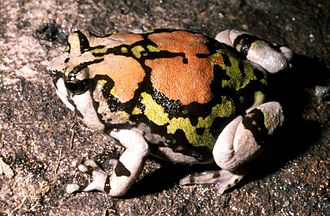Type the name of the breed you're looking for below
[wpdreams_ajaxsearchlite] Don't see the breed your're looking for? Click here and let us know!
Rainbow Burrowing Frog
| Place of Origin and Range | This frog is endemic to the central part of southern Madagascar and occurs in the Isalo Massif. It is present in the Isalo National Park where it is found in narrow canyons where the conditions are cool and humid. |
| Description | The rainbow frog is a small, roundish, brightly coloured species with a distinctive white, red, green and black pattern on the back, each area of which is clearly delineated. The skin on the back is very smooth, but that of the grey belly is a little bit rough. The snout is rounded, the eyes are prominent but the tympani are inconspicuous. The limbs are short and robust and the digits of the hand have large tips and the hind feet are webbed. Adapted for both underground and climbing lifestyles, the Malagasy rainbow frog has horny tubercles on the underside of the hind feet to help with burrowing, and claws on the forefeet for clinging to vertical canyon walls. |
| Adult Size | Can grow up to 1.5 in(3.75 cm) |
| Accommodation | It digs burrows in the sandy areas bordering the streams and at night climbs on the rock walls. It is also found in open rocky areas, mostly in dry forest. Unlike many amphibians, they do not require artificial heating. They need a large (at least ten-gallon) terrarium and do best with a substrate that will hold some humidity, such as commercial shredded bark or coconut husk bedding, or untreated topsoil on the floor of their terrarium. A shallow water dish should be included. Captive frogs should not be handled any more than necessary; when necessary, clean gloves should be worn. |
| Lifespan | Can live 6+ years |
| Feeding / Diet | Most frogs are insectivores, usually consuming flies, mosquitoes, and other small insects such as crickets. One study suggested the frog selects prey not by its size, but according to its activity level, with the most active prey being the most frequently eaten. |



